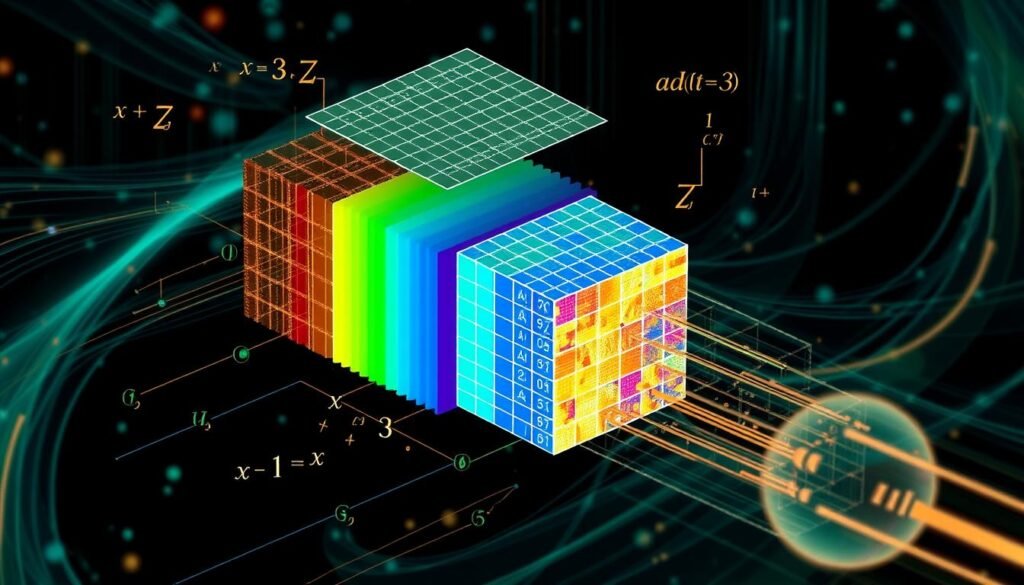In the world of artificial intelligence (AI) and machine learning, Convolutional Neural Networks (CNNs) are a game-changer. They are the heart of computer vision, changing how we see and understand the world.
CNNs are built like the human brain, making them great at recognizing images and more. They use visual data in new ways, expanding what’s possible in computer vision and deep learning.
Exploring CNNs, we’ll see what makes them so powerful and flexible. We’ll look at their history and how they’re shaping AI’s future. This guide will help you grasp the tech that’s changing our digital world.
Key Takeaways:
- Convolutional Neural Networks (CNNs) are a fundamental deep learning model for computer vision tasks, inspired by the human visual cortex.
- CNNs excel at image recognition, object detection, and scene understanding by leveraging the spatial and temporal dependencies in visual data.
- The unique architecture of CNNs has revolutionized the field of computer vision and deep learning, making them a crucial component of AI-driven applications.
- This introduction will provide a comprehensive overview of the fundamental components, historical development, and role of CNNs in modern AI applications.
- Understanding the underlying principles of CNNs is essential for navigating the rapidly evolving landscape of computer vision and deep learning technologies.
Understanding Convolutional Neural Networks (CNN): A Foundation for AI Vision:
Convolutional neural networks (CNNs) are key in artificial intelligence, changing computer vision. They mimic the human brain’s visual part. This has led to big steps forward in cnn neural network and cnn machine learning fields.
Basic Components of CNN Architecture:
A CNN’s heart has several parts that work together. The convolutional layer finds important features in images. The pooling layer makes these features smaller. Finally, the fully connected layer does the final tasks like classifying images.
Historical Development of CNNs:
CNNs started in the 1980s with pioneers like Kunihiko Fukushima and Yann LeCun. They introduced the convolutional neural network explained. Since then, better computers and more data have made CNNs even more powerful.
Role in Modern AI Applications:
CNNs are crucial in today’s AI, especially in computer vision. They help with tasks like recognizing images, finding objects, and creating images. cnn neural network and cnn machine learning have changed how we deal with visual data.

“Convolutional neural networks have become the dominant approach for solving a wide range of computer vision problems, from image classification to object detection and beyond.”
As AI keeps growing, CNNs will become even more important. They will keep helping create smarter machines that can see and understand the world.
The Mathematics Behind CNN Operations:
Convolutional Neural Networks (CNNs) are key in computer vision. They use a strong math base. At their heart are convolution layers, which use kernels to find important features in images.
Convolution works by moving kernels over the image, multiplying each element, and adding them up. This lets the network spot patterns and structures vital for tasks like classification.
The size and number of kernels, and their depth, are key. They help the network find convolution layers, kernels, and feature extraction. By adding more layers, CNNs can find more complex features.
| Convolution Operation | Kernel Size | Feature Extraction |
|---|---|---|
| Element-wise multiplication and summation | 3×3, 5×5, 7×7 | Edges, shapes, textures, and higher-level patterns |
The math behind CNNs, like convolution and pooling, is vital. It helps us understand how they process visual data. Learning these basics gives us a deeper look into this powerful technique.

“The success of CNNs in computer vision tasks can be attributed to their ability to efficiently extract and recognize relevant features from the input data.”
Essential CNN Layers and Their Functions:
Convolutional Neural Networks (CNNs) are key in computer vision. Their success comes from the layers that make up their architecture. We’ll explore the essential CNN layers, their functions, and how they work together to analyze images.
Convolution Layer Operations:
At the core of a CNN are the convolution layers. They extract features from the input image. These layers use learnable filters to create feature maps that capture patterns and characteristics.
The convolution operation slides the filter across the image. It performs element-wise multiplication and sums the results. This is done for each filter, creating feature maps that represent different visual elements.
Pooling Layer Mechanics:
After convolution layers, pooling layers are crucial. They reduce the spatial dimensions of the feature maps while keeping important features. Pooling layers use max or average pooling to selectively retain values.
This process reduces the number of parameters in the CNN. It makes the model more efficient and less likely to overfit.
Fully Connected Layer Structure:
The final layers of a CNN are the fully connected layers. They transform the feature maps into a single vector of class scores or probabilities. These layers connect every neuron in the previous layer to every neuron in the current layer.
The fully connected layers are responsible for the final classification or regression tasks. They learn complex, non-linear relationships between the extracted features and the desired output.
Understanding the essential layers of a CNN shows the power and versatility of this technique. The integration of these layers enables CNNs to excel in various computer vision applications, from image classification to object detection.
| Layer | Function | Key Characteristics |
|---|---|---|
| Convolution | Feature extraction | Applies learnable filters to the input, creating feature maps |
| Pooling | Spatial dimension reduction | Selectively retains the most important features using max or average pooling |
| Fully Connected | Classification/Regression | Transforms the spatially-reduced feature maps into a single vector of class scores or probabilities |
Feature Extraction and Pattern Recognition in CNNs:
Convolutional Neural Networks (CNNs) are great at finding features and patterns in images. They are key for tasks like image classification and object detection. This is because they can automatically learn and find important visual details from raw images.
CNNs use layers to find and learn about simple features like edges and shapes. They then mix these simple features into more complex ones. This helps them understand images well and do image classification accurately.
CNNs are not just for images. They can also work with audio and time-series data. This makes them very useful in many AI areas.
“The ability of CNNs to automatically learn and extract meaningful features from raw data is a key reason for their success in computer vision tasks.”
As AI keeps getting better, CNNs will play an even bigger role. They will help in areas like self-driving cars, medical imaging, and understanding language.
Training and Optimization Techniques for CNN Models:
Creating effective Convolutional Neural Network (CNN) models needs smart training and optimization. At the core is backpropagation, a key algorithm for training CNNs. It adjusts the network’s weights by calculating gradients, making the model better.
Choosing the right activation functions is also key. These functions decide how the network reacts to inputs. The right choice, like ReLU, boosts the model’s performance and learning speed.
Data augmentation is another vital part. It creates new training samples through rotations or flips. This makes the model more robust and less likely to overfit.
Learning Rate Optimization:
The learning rate is a critical hyperparameter. It controls how fast the model learns. Using adaptive algorithms like Adam can make the model learn faster and more accurately.
Preventing Overfitting:
Overfitting happens when a model does great on training data but fails on new data. To avoid this, use regularization like L1 or L2. These add a penalty to the loss function. Cross-validation also helps by showing how well the model generalizes.
By learning these techniques, we can make CNNs work better. This leads to more accurate and scalable computer vision solutions.
Popular CNN Architectures and Their Applications:
In the world of deep convolutional neural networks (CNNs), some designs stand out. These designs have changed computer vision and cnn artificial intelligence for the better. They have led to big steps forward in many fields.
The AlexNet model, created in 2012, was a game-changer. It showed how deep learning could excel in image recognition. Its success led to more interest in transfer learning, making it easier to use its pre-trained layers for many tasks.
The VGGNet architecture came next, building on AlexNet’s success. It has a deeper structure and focuses on simple, effective features. This made it a favorite for many computer vision tasks.
The ResNet model tackled the challenge of very deep networks. It uses “skip connections” to avoid the vanishing gradient problem. This allows ResNet to handle complex visual patterns, making it useful for many cnn artificial intelligence tasks.
| CNN Architecture | Key Features | Applications |
|---|---|---|
| AlexNet |
|
|
| VGGNet |
|
|
| ResNet |
|
|
These deep convolutional neural network designs have greatly advanced computer vision and cnn artificial intelligence. They use transfer learning to quickly develop new solutions in many fields.
Implementing CNNs with Python and Deep Learning Frameworks:
Convolutional neural networks (CNNs) are key in computer vision today. Knowing how to use Python libraries and deep learning frameworks is essential. We’ll look at the best ways to use TensorFlow, PyTorch, and other frameworks for CNNs.
TensorFlow Implementation Guide:
TensorFlow is a powerful tool for making convolutional neural network python models. It’s open-source and has a big community. It helps with everything from setting up models to improving training.
PyTorch Best Practices:
PyTorch is known for its easy-to-use pytorch cnn setup. It has dynamic graphs and great debugging tools. This makes it easy to try out keras cnn ideas and make models better.
Model Deployment Strategies:
After training your CNN models, you need to put them to work. This means using them in web apps, mobile apps, or on devices. You’ll need to think about size, speed, and where they’ll run.
| Framework | Strengths | Weaknesses |
|---|---|---|
| TensorFlow | – Robust and flexible environment for CNN development – Extensive documentation and active community – Supports a wide range of deployment options | – Steeper learning curve compared to some alternatives – Can be more complex for simple use cases |
| PyTorch | – Intuitive and user-friendly approach to CNN implementation – Dynamic computational graphs for easier experimentation – Extensive debugging capabilities | – Relatively newer framework with a smaller ecosystem compared to TensorFlow |
Using these frameworks well can help you get the most out of CNNs in your projects.
Real-world Applications and Case Studies:
Convolutional Neural Networks (CNNs) have changed the game in computer vision. They’ve made a big impact in many fields, like healthcare and self-driving cars. Let’s look at some examples of how CNNs are making a difference.
Healthcare: Revolutionizing Medical Imaging:
In healthcare, CNNs are a big help for analyzing medical images. They can spot skin cancer, breast cancer, and diabetic retinopathy very well. This AI tech helps doctors make quicker and more accurate diagnoses, which is great for patients.
Autonomous Vehicles: Navigating the Future:
The car industry is using CNNs for self-driving cars. These 3d convolution neural network algorithms help cars see and understand their surroundings. This tech is making driving safer and more efficient, without needing a human behind the wheel.
Facial Recognition: Enhancing Security and Convenience:
CNNs are also used in facial recognition systems. These systems can recognize people and unlock devices. Thanks to gpu acceleration, these systems work better and faster, making our lives easier and safer.
| Application | CNN Example | Key Benefits |
|---|---|---|
| Healthcare | Medical Imaging Analysis | Accurate diagnosis, improved patient outcomes |
| Autonomous Vehicles | Real-time Sensor Data Processing | Safer navigation, efficient transportation |
| Facial Recognition | Identification and Authentication | Enhanced security, increased convenience |
CNNs are changing the world in many ways. As they get better and more common, we’ll see even more amazing uses. They’re making computer vision and AI do incredible things.
Conclusion:
We’ve explored the amazing world of Convolutional Neural Networks (CNNs). They are key to modern computer vision and AI progress. We’ve seen how CNNs work and their role in tasks like image recognition and object detection.
The future of CNNs looks bright. They’ve changed computer vision, letting machines see and understand the world better. They help self-driving cars and medical imaging, showing their wide range of uses.
But, there are still challenges ahead. We need to keep improving CNNs. By using new methods and learning from each other, we can make them even better. This will lead to more amazing things in the world of cnn neural networks.
FAQ:
What are Convolutional Neural Networks (CNNs)?
Convolutional Neural Networks (CNNs) are a type of deep learning algorithm. They are mainly used for image recognition and classification. They automatically extract features from visual data, making them great for computer vision.
How do CNNs work?
CNNs apply convolutional, pooling, and fully connected layers to an image. The early layers detect basic features like edges. The deeper layers combine these to recognize complex patterns. Pooling layers shrink the size of these features. The final layers classify or regress the image.
What are the key components of a CNN architecture?
A CNN’s main parts are the convolutional layer, pooling layer, and fully connected layer. The convolutional layer uses filters to analyze the image. The pooling layer reduces the size of the features. The fully connected layer does the final classification or regression.
How are CNNs trained?
CNNs are trained using backpropagation. This adjusts the network’s weights to match the true labels. It involves many iterations of forward and backward passes.
What are some popular CNN architectures?
Popular CNNs include AlexNet, VGGNet, ResNet, and Inception. Each has its own design for different computer vision tasks.
How can CNNs be used in real-world applications?
CNNs are used in many areas like image classification, object detection, and medical image analysis. They also help in autonomous vehicles and facial recognition. They perform well in various industries.
What are the benefits of using CNNs?
CNNs automatically learn from data and work well with large datasets. They are efficient and can run on specialized hardware like GPUs. This makes them a strong choice for computer vision tasks.
How can I get started with implementing CNNs?
Start with deep learning frameworks like TensorFlow or PyTorch. There are many tutorials and resources online. You can also use pre-trained models and transfer learning for your tasks.





















